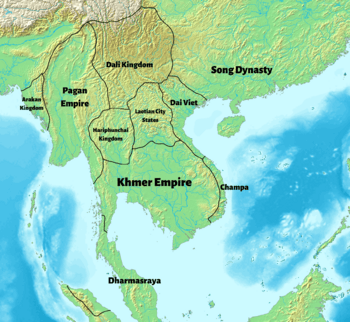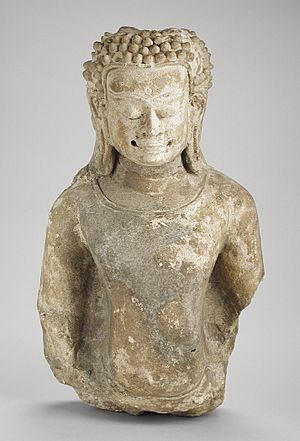Hariphunchai facts for kids
Quick facts for kids
Hariphunchai
Haripuñjaya (Pali)
|
|||||||||
|---|---|---|---|---|---|---|---|---|---|
| 629–1292 | |||||||||

Mainland Southeast Asia in 1100 CE
|
|||||||||
| Capital | Hariphunchai (Lamphun) | ||||||||
| Common languages | Northern Thai Pali Mon Lawa |
||||||||
| Religion | Theravada/Mahayana Buddhism | ||||||||
| Government | Monarchy | ||||||||
|
• 662-669, or 662-679, or 659-688
|
Camadevi (Jamadevi) (first) | ||||||||
|
• c. 1292
|
(Phraya) Yi Ba (last) | ||||||||
| Historical era | Middle Ages | ||||||||
|
• Founding by Suthep
|
629 | ||||||||
|
• More probable, supposed founding
|
c. 750 A.D. | ||||||||
|
• Besieged and captured by Kingdom of Lan Na
|
1292 | ||||||||
|
|||||||||
Hariphunchai (also called Haribhunjaya) was an old kingdom in what is now northern Thailand. It was ruled by the Mon people. The capital city was Lamphun, which was also known as Hariphunchai back then. This kingdom existed for many centuries before the Thai people moved into the area. In 1292, a king named Mangrai from the Lan Na kingdom attacked and took over Hariphunchai.
Contents
How Hariphunchai Began
According to old stories like the Camadevivamsa and "Jinakalamali" chronicles, a wise man named Suthep started the city in 629 AD. The ruler of the Lavo Kingdom (which is now Lopburi) sent his daughter, Queen Jamadevi, to be the first queen of Hariphunchai.
However, many historians now think this date is too early. They believe the kingdom actually started around 750 AD. At that time, much of central Thailand was controlled by different Mon city-states, which were part of the Dvaravati kingdom. Queen Jamadevi had twin sons. The older son became the ruler of Lamphun, and the younger son ruled the nearby city of Lampang.
Growth and Fall of the Kingdom

The kingdom grew and became strong. Under King Adityaraja, Hariphunchai had conflicts with the Khmer Empire in the 12th century. Records from Lamphun in the early 1200s show that King Sabbadhisiddhi helped build and support Buddhist temples.
Old stories say that the Khmers tried to attack Hariphunchai many times during the 11th century, but they did not succeed. It's not clear if these stories are completely true, but other Mon kingdoms in the Dvaravati area were taken over by the Khmers around that time. The early 13th century was a very peaceful and prosperous time for Hariphunchai. The old writings from this period mostly talk about religious events and building new structures, not about wars.
Despite this peaceful time, Hariphunchai was attacked in 1292 by King Mangrai of the Lan Na kingdom. King Mangrai wanted to add Hariphunchai to his growing kingdom. He sent a spy named Ai Fa to cause trouble and unhappiness among the people of Hariphunchai. This made the kingdom weaker and easier for Mangrai to conquer. Phraya Yi Ba, who was the last king of Hariphunchai, had to escape south to Lampang.
Kings and Queens of Hariphunchai
Here are the names of the rulers of the Hariphunchai kingdom, according to the Tamnan Hariphunchai (History of Kingdom of Hariphunchai):
- Camadevi, Queen
- Hanayos
- Kumanjaraj
- Rudantra
- Sonamanjusaka
- Samsara
- Padumaraj
- Kusadeva
- Nokaraj
- Dasaraj
- Gutta
- Sera
- Yuvaraj
- Brahmtarayo
- Muksa
- Traphaka
- Uchitajakraphad, King of Lavo
- Kampol
- Jakaphadiraj, King of Atikuyaburi
- Vasudev
- Yeyyala
- Maharaj, King of Lampang
- Sela
- Kanjana
- Chilanka
- Phunthula
- Ditta
- Chettharaj
- Jeyakaraj
- Phatijjaraj
- Thamikaraj
- Ratharaj
- Saphasith
- Chettharaj
- Jeyakaraj
- Datvanyaraj
- Ganga
- Siribun
- Uthen
- Phanton
- Atana
- Havam
- Trangal
- Yotta
- Yip
See also
 In Spanish: Haripunchai para niños
In Spanish: Haripunchai para niños

